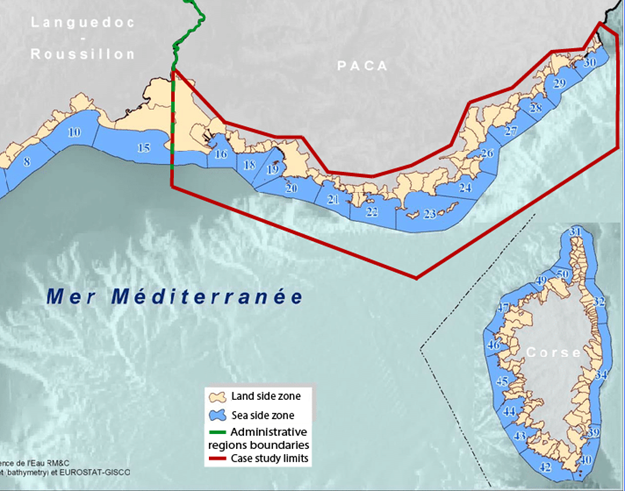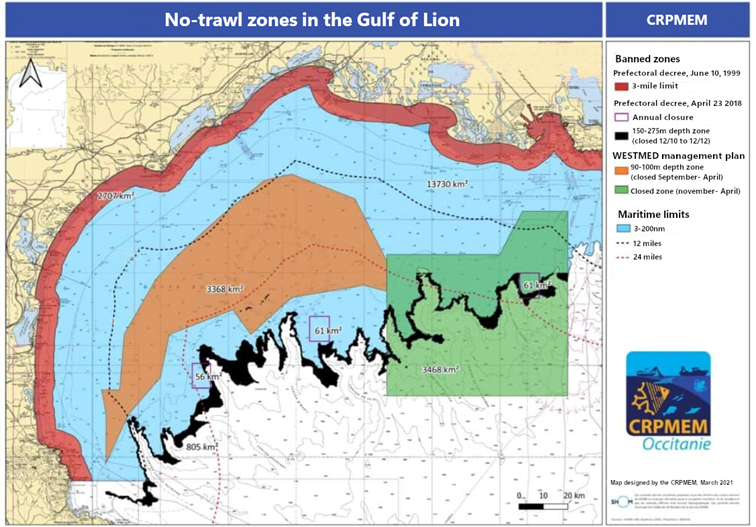The French Mediterranean Sea Case Study has assessed the effective implementation of the Water Framework Directive (WFD) and Marine Spatial Planning (MSP), focusing on France’s fishery policy governance, legislation, and implementation mechanisms.
The research assessed whether the implementation of fishery policy in France supports the European Green Deal objectives (biodiversity protection and climate change), through the analysis of the French Mediterranean region Provence-Alpes-Côte d’Azur (PACA).

Supports to biodiversity protection in France
Regulatory mechanisms
Licences and quotas
At the local level, several institutions play different roles. The Departmental Directorate is responsible for issuing fishing landing permits, operating under the authority of the Ministry of Ecological Transitions and its Directorate for Maritime Affairs. Port authorities verify that landings comply with the authorizations granted, particularly in terms of quotas and minimum catch sizes.
At regional level, the CRPMEMs are responsible for setting the opening and closing dates for fishing for certain species and for laying down the rules governing cohabitation between the various fishing professions. They also allocate fishing licences and implement measures to limit fishing effort, such as imposing minimum catch sizes, reducing vessel power, increasing mesh sizes or banning certain fishing gear.
These regional fishing committees distribute licences and quota to local organisations which themselves distribute them to fisherman. However, not all fishermen belong to a producer/regional organisation. Quotas are split between fishermen who belong to a producer organisation and those who do not, the split being based on catch history.
For membership of a fishing organisation and its quota system, arbitration for the distribution of quotas to new entrants takes into account 4 criteria, including:
- the track record of the species fished by the vessel
- the technical and economic project
- the potential for revitalising the area
- the environmental impact of the vessel (only considered if two candidates reach the same grade for the three first criteria and cannot be ranked equally).
Bans on bottom trawling
In the western Mediterranean, France imposes an annual ban on the use of bottom trawls up to 6 nautical miles from the coast in the Mediterranean Sea for a period of three months, generally from May to July, to protect fish stocks and sensitive marine habitats. These measures are part of the multiannual management plan established by the European Union to limit pressure on demersal species while respecting scientific recommendations to achieve sustainability objectives. These ban periods may be adjusted to suit specific regions, such as the Gulf of Lion, to take account of local ecological particularities and the needs of fishing communities.
The Directorate for Maritime Affairs oversees the ban, and the Maritime Préfecture and local police carry out surveillance.
The French Marine Science Institute provides scientific advice1 to set the correct areas. Following a year of implementation in 2020, an assessment was conducted, which concluded that the objectives established when the time-area closure on hake stocks was implemented have largely been achieved (a 57% reduction in catches)2 .
Due to GFCM recommendation GFCM/46/2023/1 and regulation (EU) 2019/1022, on Western Mediterranean fisheries management, several measures have been taken in the PACA region, including a temporal bottom trawling3 ban for demersal species in the PACA region (Gulf of Lion) from September to April to protect hake and red mullet.
These regulatory tools can be completed by authorisations or bans from the Maritime Prefects in Marine Protected areas.

Financial mechanisms
EMFAF funding at the national scale
The fishing industry is strongly supported by the National European Maritime, Fisheries and Aquaculture Fund (EMFAF). Between 2014 and 2020, the French fisheries sector has benefited from €588 million contributing to the funding of 3,500 projects.
From this €588 million, €250 million comes from EMFF (former EMFAF) and €300 million from French national public aid4. A new EMFAF phase is ongoing from 2021 to 2027.
The fund was distributed in accordance with key priorities, including the promotion of competitive fishery and aquaculture industries, as well as the steering of the fishing and aquaculture industries towards sustainable development. To support these two priorities, a list of eleven objectives has been established, including one objective on CO2 reduction and one objective that was not included in the 2014-2020 program on biodiversity protection. In alignment with these objectives, 1,500 businesses were supported, and 200 projects were funded to protect the marine environment, including support for 50 Natura 2000 protected sites5.
EMFAF funding at the regional scale
In the PACA region, EMFAF is managed by the Regional administrative. Through this fund, the Region can boost fisheries sector through economic aid but also influence the implementation of the MSFD and EGD indicators and objectives by deciding on the conditionality of the allocation of these funds. Complementary funds can be distributed through FLAGs, a group of local stakeholders comprised of maritime professionals, associations, local authorities, businesses, and other relevant entities. These groups convene to select local projects supported through EMFAF funding making it effects more tangible at local level.
A total of 71 projects6 related to small-scale professional fisheries were supported in the PACA region during the 2014-2020 EMFAF program (with exception of COVID fundings to support the industry). Among these projects, 18 focused on biodiversity protection, pollution, and data acquisition. The majority of these projects focused on the management of protected areas, and only one action was financed to actively change practices in the sector (support to a fisherman for the purchase of a newer vessel that consumes less fuel).
Between 2021-2024 (2021-2027 EMFAF program), 35 projects7 were supported in the PACA region, of these, one action focused on enhancing marine biodiversity knowledge, while twenty-two actions aimed at hiring a marine guard (one per Natura 2000 or marine protected area) to raise awareness among visitors and users of protected areas about marine challenges. However, no project has yet been funded to changes practices in favour of marine biodiversity protection in the sector.
The EMFAF has a national and regional scope aiming to fit with local needs. One of the financial sub-measures of the EMFAF is ‘local development led by local actors’ which aims to ‘Enable a sustainable blue economy in coastal, island and inland areas and promote the development of fishing and aquaculture communities. The EMFAF has been expanded to include more than just professional fishermen at local level. This local envelope has been allocated €2 million in the PACA region and is distributed by local professional organisations in order to best adapt to the needs of local fishermen.
Alignment with MSFD descriptors on biodiversity protection
At the French Mediterranean Sea scale (including the PACA region), MSFD implementation is coordinated by the Interregional Directorate of the Mediterranean Sea through the French Mediterranean Sea strategy and program of measure. Three of the MSFD descriptors are closely linked to the fisheries sector including healthy fish stocks (D3), seabed integrity (D8), and the non-introduction of non-indigenous species (D2). The French Mediterranean Sea program of measures is composed of 81 actions, 13 of which are related to the fisheries sector. These 13 actions include a full chapter of measures on halieutic resources management and four actions on biodiversity protection and fisheries.

The EMFAF is used to support these actions. During the EMFAF call for project drafting, the Interregional Directorate and the Region (managing EMFAF) work closely to ensure coherence between EMFAF-supported projects and the French Mediterranean Sea program of measures.
The 2021-2027 national fisheries operational program is aligned with the priorities of this program of measure, focusing on environmental sustainability, innovation development, the promotion of sustainable aquaculture, and the marketing and processing of fishery and aquaculture products. A clear mention is made to the French Mediterranean strategy and the science-policy interface: “Priority will be given to projects that include a dimension of improving knowledge of the impact of climate change on stocks of interest to fisheries. Projects will be able to draw on data sets collected within other frameworks, in particular data collected under the Ddata collection framework (EMFAF specific objective OS1.4) or the MSFD8”.
However, despite these close links on paper, the National EMFAF strategy primarily focuses its biodiversity funds efforts on data collection and raising awareness in MPAs. EMFAF is not yet sufficiently oriented to be used as a concrete incentive for fishing that is closely linked to the sustainable use of resources. The main mechanisms for enforcing compliance with CFP stock sustainability objectives and MSFD indicators remain regulatory and coercive, through temporary bans and landing obligations.
Conclusions
References
- Identification of the most relevant period for the 3-month ban each year on trawl fishing within 6 miles of the coast in the mediterranean sea, May 2019, Ifremer
- Evaluation of space-time closures implemented from January 1, 2020 for trawl fishing in the Mediterranean Sea, July 2021, IFREMER
- Order of 20 December 2019 amending the order of 28 February 2013 adopting a management plan for professional trawl fishing in the Mediterranean Sea by vessels flying the French flag https://www.legifrance.gouv.fr/jorf/id/JORFTEXT000039668169
- https://agriculture.gouv.fr/quest-ce-que-le-feamp
- https://agriculture.gouv.fr/quest-ce-que-le-feamp
- Excel list beneficiaries 2014-2020 EMFAF – update 2024, l’Europe en France
- Excel list beneficiaries 2021-2027 EMFAF – update January 2025, l’Europe en France.
SFC 2021 EMFAF Program, p 9-10: https://www.europe-en-france.gouv.fr/sites/default/files/programme_national_feampa.pdf